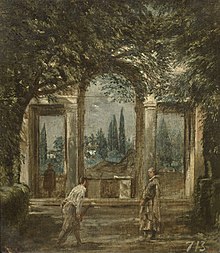
The Sleeping Ariadne, housed in the Vatican Museums in Vatican City, is a Roman Hadrianic copy of a Hellenistic sculpture of the Pergamene school of the 2nd century BC,[1] and is one of the most renowned sculptures of Antiquity.[2] The reclining figure in a chiton bound under her breasts half lies, half sits,[3] her extended legs crossed at the calves, her head pillowed on her left arm, her right thrown over her head. Other Roman copies of this model exist: one, the "Wilton House Ariadne", is substantially unrestored,[4] while another, the "Medici Ariadne" found in Rome, has been "seriously reworked in modern times", according to Brunilde Sismondo Ridgway.[5] Two surviving statuettes[6] attest to a Roman trade in reductions of this familiar figure. A variant Sleeping Ariadne is in the Prado Museum, Madrid.[7] A later Roman variant found in the Villa Borghese gardens, Rome, is at the Louvre Museum.
Purchased from the Roman Angelo Maffei[8] in 1512 by Pope Julius II, it was immediately installed in the Belvedere Courtyard, which links the Vatican Palace with the papal casina called the Belvedere; there its neighbors were the recently discovered Laocoön and the Belvedere Apollo. Once she had been initially identified as Cleopatra[9] because of the snake bracelet on the upper left arm, which was taken for the asp by which she died, supportive narrative could easily be brought to bear: Ulisse Aldrovandi thought he detected that "she appears to have collapsed and fainted",[10] and a sense of fitful uneasiness has been ascribed to her by the modern viewer Sheila McNally (below).
The "Cleopatra" became the main model[11] through which a conventional pose signifying sleep,[12] with one elbow cocked above the head, was transmitted from Antiquity to High Renaissance and later painters and sculptors.
T.B.L. Webster noted the uneasy pose of the sleeper, between sleep and wakening, a Hellenistic innovation in the sleeping Ariadne motif long known from vase-painting, which now placed greater emphasis on the stress of Ariadne herself; perhaps, Webster suggests, it was reflecting a new, literary source that has not survived.[13] Sheila McNally detected in the sculpture a new "sense of unease that informs the whole" and "an effort to throw off some inner discomfort — a sluggish effort, restrained by a slumber that is more oppressive than relaxing. Her drapery bunches about her legs, imprisoning her loins."[14] Soon she may wake to threaten vengeance on Theseus, as in Catullus' description in "Peleus and Thetis".[15]

- ^ Wolfgang Helbig, Fürer durch die öffenticher Sammlungen klassischer Altertümer in Rom, 1969 I:109f; the extent to which such copies are free pastiches is always an unknown.
- ^ The high reputation of the Sleeping Ariadne is sketched by Francis Haskell and Nicholas Penny, Taste and the Antique: the lure of classical sculpture 1500-1900, 1981, cat. no. 24 (as Cleopatra):184-87.
- ^ The unobtrusive rockwork is restored.
- ^ "The Wilton House Ariadne, totally unrestored, is therefore of great importance in suggesting a more horizontal position than the Vatican figure" observes Brunilde Sismondo Ridgway, Hellenistic Sculpture: The Styles of ca. 331-200 B.C. 2001:331; the Ariadne is discussed pp 330-32.
- ^ Ridgway 2001 eo. loc..
- ^ In Providence, Rhode Island (pose reversed), and San Antonio, Texas.
- ^ Prado E-167, illustration.
- ^ The Maffei had already accumulated an extensive assemblage of sculptures, reliefs and inscriptions that had been unearthed on the properties.
- ^ Leonard Barkan, "The Beholder's Tale: Ancient Sculpture, Renaissance Narratives" Representations 44 (Autumn 1993:133-166) explores the rhetoric inextricably tied to decoding this image (ekphrasis) and providing a narrative for it, whether "Cleopatra", "Sleeping Nymph" or "Ariadne"; Peter Higgs, "Searching for Cleopatra's image: classical portraits in stone", in Susan Walker and Peter Higgs, Cleopatra of Egypt. From History to Myth, 2001, begins with the Sleeping Ariadne misidentification before moving to historical portraiture of Cleopatra.
- ^ Aldrovandi, Delle statue antiche, Venice, 1556, quoted in Barkan 1993:138 note 18.
- ^ The Barberini Faun was not found until the 1620s, by which time the convention had been thoroughly established
- ^ Sheila McNally, "Ariadne and Others: Images of Sleep in Greek and Early Roman Art", Classical Antiquity 4.2 (October 1985:152-192), esp. 170ff; Brunilde Sismondo Ridgway, "A Story of Five Amazons", American Journal of Archaeology, 78.1 (January 1974:1-17), notes archaic representations of the dead and dying and briefly sketches the progression of the pose as it was extended to other figures; compare the sleeping pose of Endymion on sarcophagi and in post-Renaissance paintings.
- ^ Webster, "The myth of Ariadne from Homer to Catullus", Greece and Rome 13 (1966:22-31) pp 29-31.
- ^ McNally 1985:172.
- ^ Quoted by Webster 1966:30
- ^ Now conserved in the Museo Archeologico, Florence